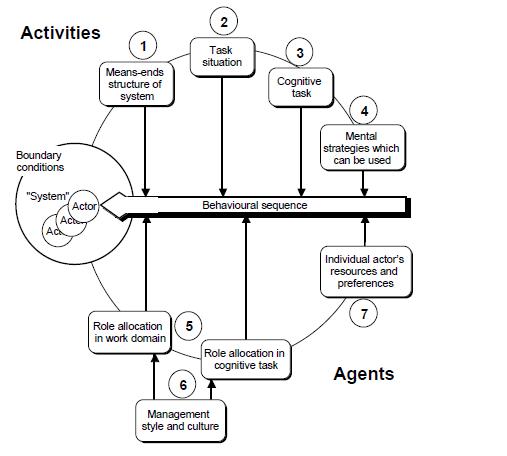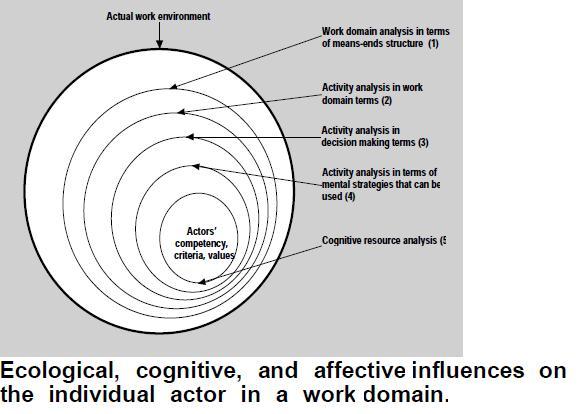這次來演講的大師是來自華盛頓大學的Raya Fidel,主題是人與資訊互動(HII)以及Cognitive Work Analysis(CWA)的介紹和應用。
卜老師有說CWA這框架較適合用在政府部門,也很怕這分析會失傳,如果研究有關這方面及興趣,可以嘗試用這分析框架去研究喔~
[Human-Information Interaction]
What is Human-Information Interaction ?
HII = the interaction between people and information with its multiple forms and purposes.
→ To help people to make decision
→ not just in computer, 也就是說人與資訊的互動未必是要跟電腦系統(搜尋引擎之類的)有關,這是很多人對資訊的迷失。
記得:資訊是不分人跟系統的!
The seven kinds of HII:
1. Information seeking - 尋找你所要的資訊
Type by level of purpose:
→ Searching - 有目的地去搜尋
→ Surfing - 漫無目的地瀏覽,當初講解到這詞時,引起許多老師與大師對這詞的定義及釐清,但我那時很想舉手用很詼諧簡單的方式去描述這詞,Just like that "You take a board to go surfing, and stand the top of the wave, all the wonderful view in your eyes, just enjoy it. Not for purpose, just enjoy~"其實就很簡單,surfing一詞其實就是源於衝浪這原意,只是被借來用在電腦的檢索行為上,但追溯其字的原意,來去看待這行為時,其實就不難懂了。
Raya還提到跟"browsing"的差別,browsing has a strategy, when you purpose to find sth.
→ Encountering - bumping into information,also called "Accidental discovery of information" & "Incidental information acquisition", 指在不預警的情況下,突然碰到這資料訊,而這資訊對你而言是可以解決你的需求的。現在還有另一個新辭彙是"serendipitous",這意思也是有偶然發現之意,但這偶然發現的資訊是對你有幫助並可以再做加值創造的。
2. Information evaluating - also called "Relevance judgement", "Compare" & "match", 如何知道你所找到的資訊是你要的或是與你相關的?換句話說,就是要能解決你的需求。
大師有提到The level of relevance,目前有一個issue:difficult to evaluate the relevance of results in IS.
3. Information avoiding - 拒絕過多的資訊來源,像資訊超載與資訊焦慮,都是我們所避免及抗拒的。
4. Information use - The outcome of acquiring information, 注意這邊是outcome,也就是說這結果對他而言是有用、有價值的。<詳情可見outcome與output差異這篇>
5. Information representing - creating surrogates to represent information, like abstracting, indexing/tagging, information visualization(例:NASA for convey, clusty.com, etc.....)
→ help information seeking
→ 是一種資訊的互動
6. Information filtering - also called "Selective Dissemination of Information(SDI)", 過濾及避免一些不相關的資訊
7. Information giving - 回饋(feedback)或傳播訊息,這詞有教授說比較舊了,似乎是90年代理文獻才會出現的辭彙,在這知識經濟的時代裡,我想應該與知識管理的Information sharing概念一樣或是不會差太多。
在提到以上這些資訊的動作或過程時,要先知道最基本的就是↓
What is information need a basic concept ? & What is it ?
通常是在你的認知上無法適足的理解這個目標或主題時,當然也有可能是在無目的的瀏覽情況下,突然觸發你對資訊的需求。
當你有了資訊需求時,你通常會有這四個步驟逐漸去滿足你的需求↓
Stages of Need Development(Taylor)
1. Visceral(未知)
2. Conscious(去想)
3. Formalized(make sense)
4. Compromised(組織)
而資訊需求的種類又可分為以下兩種:
1. By Nature of Expected Answer
→ Known item need - The answer that is require d is a certain, known item.
→ Subject need - The answer that is required is information on a particular subject, or of a particular kind
2. By the Generator of the Need
→ Self need - A need generated by the person who is looking for the answer
→ proxy need - A need generated by another(imposed need)
那HII跟HHI(Human-Human Information)有何差別?
HHI是指人與人之間的溝通,至於溝通的內容未必是資訊,也可能只是一個寒暄的問話,例:How r u going on, today?
所以,HII涵蓋了HHI。
[認知工作分析 Cognitive Work Analysis, CWA]
Other name: Cognitive Systems Engineering or Ecological Systems Design.
由 Rasmussen 等人(1994)所發展的一種工作中心概念架構。其目的是為了分析認知性工作。此架構的理論基礎來自於:系統化思維(general 系統思考)、適應控制系統(adaptive control systems)、Gibson的環境心理學(Ecological Psychology);以及各種不同工作領域中支援系統開發的實地研究。從1960年代至今,統稱為認知系統工程(cognitive systems engineering)。(Vicente, 1999)
What is CWA ?
CWA as a theoretically motivated layered approach to the analysis, design, and evaluation of human-computer interactive systems.
→ 提供一個概念性的框架工具,用來對工作認知的分析。
→ 這分析的目的是用來指導資訊系統服務的設計,畢竟人資互動是一個很複雜的現象。
☼CWA的主要目的:
用來幫助增進人資之間的互動,透過:
→ 增進系統、程式以及服務的設計。
→ 透過好幾個面向來分析這同時間的互動。
☼涵蓋的層面有:
→ 人,例:認知、教育、經驗...
→ 過程和活動
→ 組織,例:行政管理、社會、政治...
☼Basic Assumptions:
→ 人資系統應該要很合諧的共同運作。
→ 科技與服務是為了支持人類而創造的,而非衝突、相觸。
→ To be able to design systems that can act rhis way, one has to unsderstand:
→ ♪ The interaction with information of the people involved.
→ ♪ The work they do.
→ ♪ The context in which they work.
→ ♪ The reasons for their actions.
☼Common Concepts:
Instead of "user" and "non-user":
→ Actor = People acting in a certain context.
Instead of "factors", "independent variables", etc.:
→ Constraints = Elements that affect/shape a phenomenon and cannot be changed, and you have to unsderstand:
→ ♪ The elements that limit the possibilities for action.
→ ♪ Constraints do not hinder action.
→ ♪ In fact, they enable action.
→ ♪ They also shape action.
☼CWA differs from techniques commonly found in human factors and human-computer interaction (HCI) because of its unique combination of the following factors:
1. It relies upon the integrated input of the methods of multiple disciplines rather than being connected to a single discipline. 即它是眾多學科、知識領域的整合,而非單一的。 (看下圖的結點及解說)

the fundamental concern is to invoke behavioural sequences that will lead to effective actions and adaptations by actors on a system. CWA views such behavioural sequences as being determined by multiple sources—on the one hand by properties of the work environment, the task, and ways the task can be done (see Activities 1 through 4 at top of Figure) and on the other hand by properties of the agent(s) carrying out activity (see Agents 5 through 7) such as social and organisational roles, and individual competencies.When analysing, designing and evaluating systems we need to be able to describe these levels and shown how they relate to each other.
2. 它是一個系統而不是面向心理導向的方法,雖然在許多地方,它使用的心理學理論。
3. 它是一個動機的生態學。不是模擬活動、心智模式和使用結果作為基礎的設計,而是以一個可能發生的活動或概念為背景的生態學為模型。此生態也系統性地限制活動,然而也提供了行為上的可能。(參考前面的Constraints)
4. 當然,這模型不只是活動(小)上,也包涵了任何活動上可能會發生的情境(大)。這源於一種認知,即人類的行為在此生態,是採取任何行動可能性的決定性角色。
5. 它提供生態(人機)界面設計的依據,讓人能透過直覺的方式去操作,幫助人類盡可能感受無工作量的方法。
6. 它允許新系統的設計方式進行,來獨立解決先前的技術問題。因此,它是一種形式的分析,即不規範(主動指導活動如何進行),也沒有描述(被動地介紹了現有的活動),而是被稱為"形成的(formative)",因為它引道未來(人機)界面的一個形式,並試圖地將該界面形成一個領導人類最有效益的行為模式。
7. 它的目的是設計(人機)界面,非常適合幫助人類之前所未遭遇活動的狀況下,尤其是在可能涉及高風險的情況下。
☼If we look just at the factors bearing on the behaviour of an individual human actor within a system, they range from the physical and engineering constraints of the work domain itself, to the cognitive, perceptual, and affective properties of the individual actor (看下圖).

If we are to achieve a coherent understanding of humansystem interaction, we need clear-cut ways to connect the modelling at the five levels shown below:
1. Work domain analysis
2. Activity analysis in work domain terms
3. Activity analysis in decision terms
4. Activity analysis in terms of mental strategies
5. Cognitive resource analysis of individual actor.
These five levels would result in an effective analysis of how an individual human agent interacts with a
system and what the interface design requirements are.
☼CWA Dimensions:

如上圖,從The Work Environment → Work-domain analysis(WDA) → Organizational analysis → Activity analysis(有分為三:Task analysis → Decision analysis → Strategies analysis) → User's resources and values analysis,一曾一層的去解析認知行為與社會脈絡的情境架構。
☼CWA has various templates to support the analysis of complex phenomena. One of them is the:
Means-Ends Analysis(手段–目的分析) that is based on:
An abstraction hierarchy(一個階層性的描述).
假設給你一個任務,你要去分析:
→ Goals/Constraints: 前者要去描述目的;後者要切記是不可變之因素。
→ Priorities: 優先全不一定要有順序,但這是可變之因素!
→ Functions: 在這所要描述的功能,就是指"動作",描述詞要簡短,不宜冗贅!
→ Processes: 描述過程
→ Resources: 尤指physis
(有簡單的範例,有興趣可以來問。)
☼Means-Ends Analysis(手段–目的分析)的優點:
→ 可應用在很多方面,例:work domain, task, and decision.
→ 可以透過不同的觀點來分析整個面向
→ 可以清楚的揭開各層的關係並作為行為觀察的解釋基礎。
☼Critisim of CWA:
→ It cannot be generalized from one context to another.(這不能一概而論的從這個情境套用到另一個。)
→ It is highly resource demanding.(這是高度的資源需求。)
資訊科學與認知工作分析:
研究者可透過認知工作分析研究一資訊系統內之認知性工作。在此,「資訊系統」此一概念指任何一種系統,不論是心智的或是電腦的。此「資訊系統」能促進並協助人資互動。因此,一座圖書館整體而言可以被視為是一個資訊系統;參考服務櫃檯,網際網路,OPAC(線上公共編目),編目部門,也都能被視為是一個資訊系統。(Fidel & Pejtersen, 2004)
在資訊行為研究的脈絡中,認知工作分析被視為一種綜合了認知取向與社會取向的多面資訊行為研究取向(Pettigrew, K. E., Fidel, R., &Bruce, H. ,2001)。認知工作分析以五個抽象層次檢視資訊行為:目的與限制、優先性、工作概念、工作程序、物質資源。即,認知工作分析能提供了資訊行為研究一分析認知行為與社會脈絡的分析架構。
網路來源:
1. XXC@Note - [Cognitive Work Analysis [認知工作分析]
2. From information behaviour research to the design of information systems: the Cognitive Work Analysis framework
文獻來源:
1. Cognitive Work Analysis and the Analysis, Design, and Evaluation of Human-Computer Interactive Systems - Penelope Sanderson
2. A Multidimensional Approach to the Study of Human-Information Interaction: A Case Study of ollaborative
Information Retrieval - Raya Fidel, Annelise Mark Pejtersen and Bryan Clea, Harry Bruce.
3. 人與資訊互動 - 方法與應用之專題研習手冊

沒有留言:
張貼留言